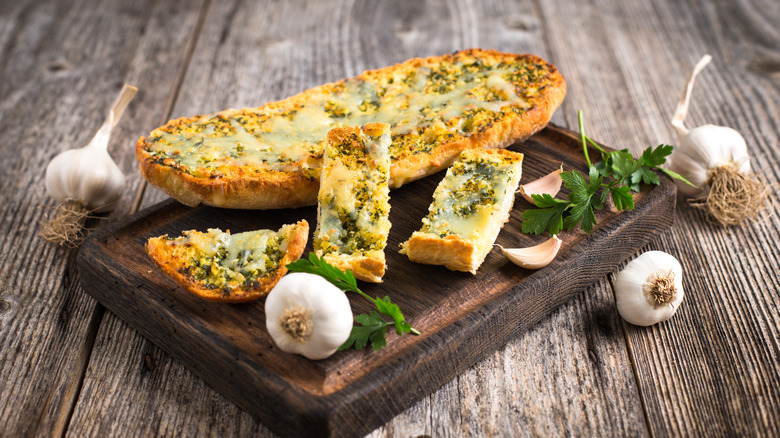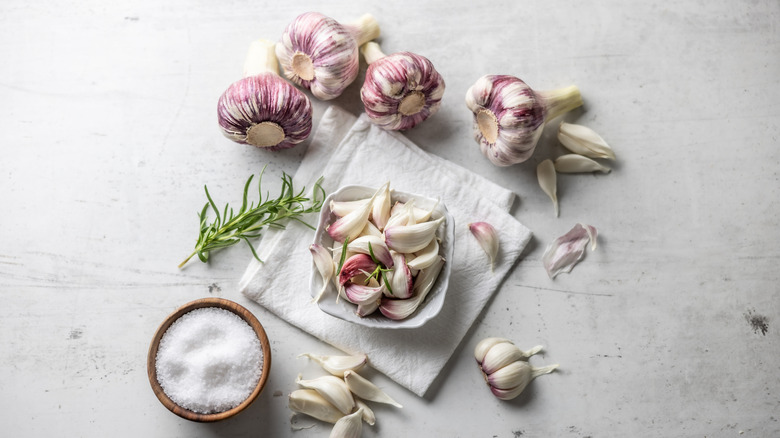Why Restaurant Garlic Bread Always Tastes Better Than What You Make At Home
There's a je ne sais quoi quality about garlic bread made in restaurants that satiates your palate like homemade garlic bread never can. This is true for most people, unless you're a food wizard who knows the magic route to perfecting the side dish, which, by the way, isn't all that Italian despite what many think. So, what do restaurants do differently? While the answers vary, from using different varieties of cheese or a particular type of bread, to the proportion of each ingredient, one rule that's sacrosanct to most chefs and almost comes as a reflex is adding gobs of butter. The creamy-rich center you dig into in that warm, fluffy restaurant-made garlic bread essentially comes from butter — good quality butter. "Use more butter than you think [you need] to smear on your bread," Jonathan Basch, a chef at Cento Italiano in Columbus, Ohio, told Reader's Digest when asked about why garlic bread at restaurants always tasted better.
Of course, butter can make just about anything taste better (no surprise there). But chefs use a specific method to spread the butter without making it too greasy. According to Chef Jean-Pierre, one common garlic bread mistake is starting with cold butter. Softened butter spreads more easily and mixes well with herbs or garlic. And if you can get your hands on some good salted French butter, that would be even better. Add a bit of olive oil to the melted butter if you don't want your garlic bread to get too rich. Olive oil will help lighten the dish.
Fresh ingredients are a non-negotiable
Another reason the garlic bread at restaurants tastes sublime is that chefs always use fresh ingredients, especially garlic. They may look at you with disdain if you mention confit and pre-minced stuff. Don't even think of garlic powder, that would be downright blasphemy. But there's a good reason why using fresh garlic is so important to chefs. Preserved or processed garlic often lacks allicin, the compound that gives garlic its distinctive smell. And really, what's the point of a devilishly soft, crunchy garlic bread if it doesn't hit you with that garlicky punch?
The same goes for herbs. Austrian chef Wolfgang Puck uses a technique that blends all the aromatics with fresh garlic, creating both even flavor and layered depth. He combines garlic, basil, rosemary, sage, chili flakes, and a pinch of salt. Then, he purees the mix while slowly drizzling in olive oil with the blender running. Renowned chef Rachael Ray uses smashed garlic for her garlic bread recipe.
Restaurants also use a lot of garlic for garlic bread, so if you're trying to replicate the taste, don't be shy with it. Italians might cock an eyebrow at how much you're using, but it's a must if you're chasing that restaurant-style garlic bread experience. If you're worried about peeling so much garlic, we have tried-and-true methods to make peeling garlic easier. If you don't enjoy that pungent flavor, blanch the garlic in white wine for a few minutes before mixing it into the butter.
Other things restaurants do differently to make garlic bread
The variety you use also plays a defining role in the texture of your finished product, so it's important to know the best types of bread to use for garlic bread. Most restaurants stick with French bread, particularly baguettes, for crisp crusts and airy interiors. Ciabatta works well too, as its porous crumb soaks up the butter and picks up the flavors nicely. Celebrity chef Ina Garten swears by it for her garlic bread recipe. No matter which bread you go with, skip the pre-packaged kind. You're better off heading to a bakery and grabbing the freshest loaf you can find. Cheese is also an important player here. Many restaurants, including Pizza chains that serve the best garlic bread, use a mix of parmesan or mozzarella.
A very important step chefs rely on is a foil wrap. Many of us tend to overbake garlic bread in our quest to get that crunchy crust. The foil wrap trick keeps the interior tender while the crust crisps, but it's still important to time it right.


